
Go into nearly any commercial gym, and you’re likely to find a Smith machine or two in a corner somewhere. More often than not, you might find it deserted in favor of lifting platforms and highly-muscled folks deadlifting 500 pounds. Indeed, the popularity of barbell exercises from the back squat to the clean & jerk has made the humble Smith machine seem obsolete.
But if you’re training alone and aiming to push yourself through failure on the bench press, you might want to reconsider the next time you ignore the oft-neglected apparatus. The Smith machine bench press is an outstanding exercise that offers significant yet untapped upper body gains.
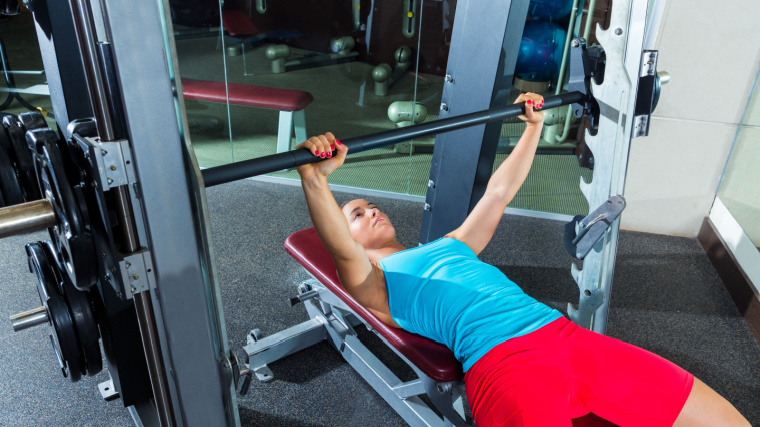 Credit: lunamarina / Shutterstock
Credit: lunamarina / Shutterstock
Countless lifters from years past have made the Smith machine bench press a staple in their routines. Here’s how to do it, why you should try it, some alternatives, and common mistakes to avoid.
- How to Do the Smith Machine Bench Press
- Smith Machine Bench Press Variations
- Smith Machine Bench Press Alternatives
- Benefits of the Smith Machine Bench Press
- Muscles Worked by the Smith Machine Bench Press
- Who Should Do the Smith Machine Bench Press
- Common Smith Machine Bench Press Mistakes
- Frequently Asked Questions
How to Do the Smith Machine Bench Press
The Smith machine bench press is performed similarly to your standard bench press, but there are some unique differences. Here’s how to do it.
Step 1 — Setting Your Base 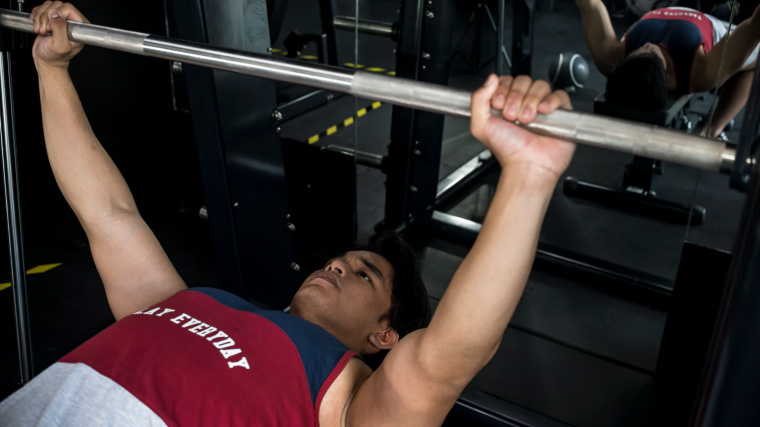 Credit: MDV Edwards / Shutterstock
Credit: MDV Edwards / Shutterstock
Place an adjustable bench in the Smith machine rack. Lie down flat on your back with the bar lined up approximately midway between your collarbone and your belly button. Make sure your feet are flat on the floor and that you’re able to unrack the bar.
Coach’s Tip: Remember to take advantage of the safety bumpers. Line them up at approximately chest height when you’re lying on your back.
Step 2 — Setting Your Grip
Tuck your shoulder blades back and down, engaging your lats with your arms fully extended in front of your body. Grip the bar evenly between each hand, taking care to stay dead center on the bench and the machine. Maintain this grip width with your shoulders back and down for the duration of the set.
Coach’s Tip: If your Smith machine bar doesn’t have any markings, create your own. Try draping a lifting strap in the middle of the bar before you set up.
Step 3 — Arch 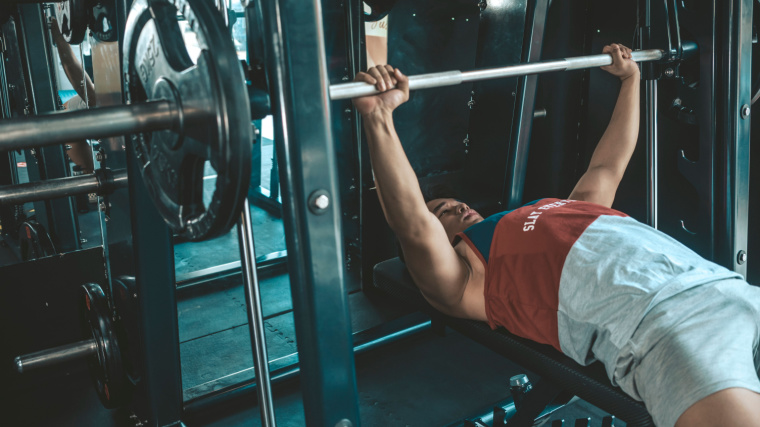 Credit: MDV Edwards / Shutterstock
Credit: MDV Edwards / Shutterstock
Keep your hands on the bar and create a tight natural arch through your thoracic spine. Pull your upper back toward the bar, keeping your lats engaged. Plant your feet flat on the floor where your body has moved to create the arch to maintain this new position.
Coach’s Tip: The bar should now be directly above the highest part of your chest due to your arch.
Step 4 — The Descent 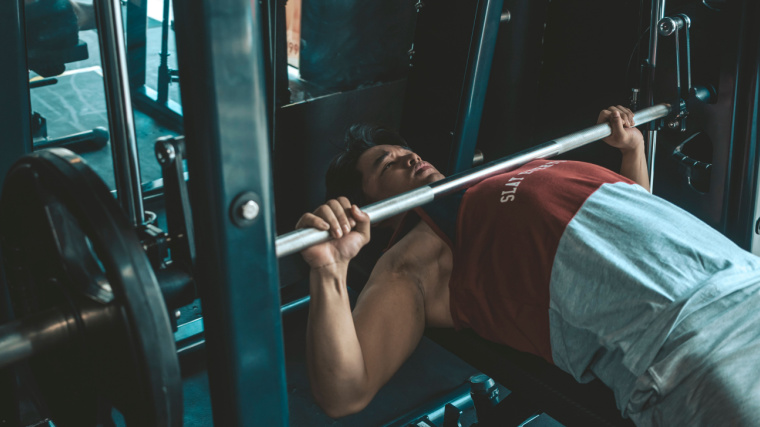 Credit: MDV Edwards / Shutterstock
Credit: MDV Edwards / Shutterstock
Maintain five points of contact — both feet on the floor, your butt, upper back, and head on the bench. Begin a slow and controlled descent through the first repetition, making micro-adjustments to your grip to accommodate your body type and mobility. Stop once the bar reaches your chest or you feel your hands, wrists, elbows, or shoulders starting to lose position.
Coach’s Tip: The Smith machine bench press may not reach your chest on each repetition, and that’s okay! The full range of motion (ROM) is going to be unique to your body.
Step 5 — Press 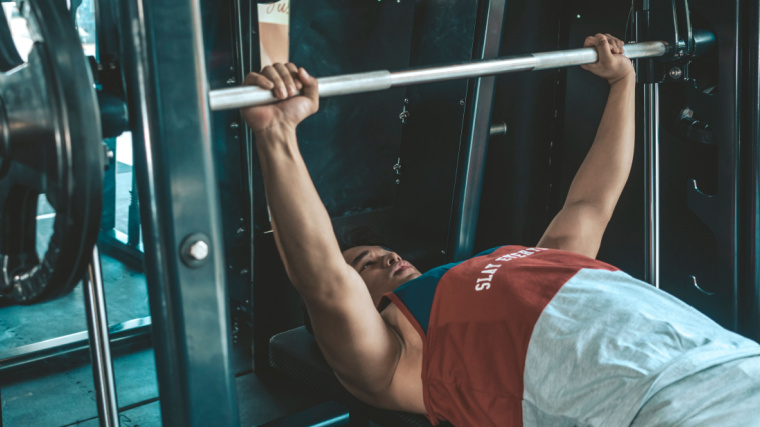 Credit: MDV Edwards / Shutterstock
Credit: MDV Edwards / Shutterstock
With your feet flat on the floor, create huge leg tension by pushing into the ground. Maintain your arch and use this leg drive to stay as tight as possible. Push the bar back to the starting position, making sure to stop before you untuck your shoulders.
Coach’s Tip: Think of performing a quad extension to engage your leg drive.
Smith Machine Bench Press Variations
The Smith machine bench press is a great asset for building your upper body strength. There are also a handful of useful variations to complement your chest workouts further — here they are.
Close-Grip Smith Machine Bench Press
[Read More: 5 Bench Press Programs to Build a Bigger, Stronger Chest]
- Set up your close-grip Smith machine bench press in the same way as your standard setup.
- Adjust your grip an inch or two closer than normal on either side.
- Perform repetitions, emphasizing your triceps by keeping your arms tucked closer to your body.
Paused Smith Machine Bench Press
[Read More: The Best Online Workout Programs For Coaching, Cardio, Value, And More]
- Set up on the Smith machine as you normally would, getting tight before you unrack.
- Lower the bar under control, reaching your chest or the point where you feel you would begin to lose position any lower.
- Pause the bar for one to two seconds before driving it back to the starting position.
Incline Smith Machine Bench Press
[Read More: The Best Back Workout for Men, Women, Strength, and More]
- Set up on the Smith machine and adjust your bench to the first or second inclined position.
- Sit down on the bench. Set your grip by placing your shoulder blades back and down and grabbing the bar.
- Drive your body into the bench by pushing with your legs.
- Descend the bar until it touches your chest or where you feel like you’d lose position. Drive the bar back to the starting position and perform for repetitions.
Smith Machine Bench Press Alternatives
If you’re looking to swap out the Smith machine bench press for some helpful alternatives, look no further than the Smith machine push-up, chest press machine, and Smith machine JM press.
Smith Machine Push-Up
[Read More: Build a Titanic Torso with These Bodybuilding Chest & Back Workouts]
- Set the height of the Smith machine bar to accommodate your strength or repetition goals. The higher the bar, the less load you press.
- Set your shoulders back and down to find your grip, place your hands evenly on the bar, and lean your body weight into the machine.
- Control your descent by slowly bending your elbows. Use the ball of your foot to create a pivot point on the ground. Press yourself back to the starting position once your chest has reached the bar.
Chest Press Machine
[Read More: Get Freakishly Strong With the 5×5 Workout Program]
- Choose the chest press machine of choice: either flat, incline, or decline. Converging machine orientations work best here.
- Adjust the seat so the hand grips align roughly with your armpit height.
- Push yourself into the bench using your feet, grip the handles tightly, and drive out until your elbows are fully extended. Control the descent back to the starting position, and perform for repetitions.
Smith Machine JM Press
[Read More: How to Do the Lat Pulldown for a Wider Back and Better Pull-Ups]
- Set up on the Smith machine similar to how you would do your close-grip bench press.
- Initiate your descent by bending your elbows, but keep your arms tucked close to your body.
- Each repetition will be a combination of a skull crusher and a close-grip bench press. The bar path should be roughly over the top of your nose.
- Lower the bar as you would with a skull crusher, keeping your upper arms in place but bringing your forearms down with the bar toward your face. Maintaining that same position, press the bar up as you would with a close-grip bench press.
- Reset and repeat for reps.
Benefits of the Smith Machine Bench Press
Although the Smith machine bench press gets a lot of negative attention from those would would prefer a barbell, it is extremely beneficial. This lift allows you to perform one of the best upper body exercises using an extremely stable machine. This makes building muscle extremely straightforward — and less risky when you’re training alone.
High Stability
Free weights are a huge asset in the gym. They are easy to use for progressive overload as you increase strength and build muscle over time. However, before a free weight is as effective as it should be, you first need to groove the pattern. Learning to stabilize an exercise is a prerequisite to safely and effectively executing it for your goal.
With the Smith machine, the bench press pattern itself is maintained in a very specific position. The restricted range of motion makes the exercise extremely easy to execute without running into stability plateaus. This higher level of stability makes it a lot easier for you to simply hop in and sprint towards gains.
[Read More: The Ultimate 10-Week Powerbuilding Workout Routine for Mass and Strength]
It should be noted that if you’re a powerlifter, you might want to avoid using this as a training tool since you’ll want to train as specifically as possible for the barbell bench press. That said, if you’re in the offseason and want to train without a spotter — or concern for stability — you’re in luck here.
Upper Body Strength With Less Fear
The Smith machine bench press is a subtle twist on your standard bench press. Both recruit a ton of muscle mass and are some of the most highly loadable upper body exercises in the gym.
The higher you’re able to load an exercise the more top-end strength you’ll unlock. Add in the high stability benefit of the Smith machine and your upper body strength can skyrocket.
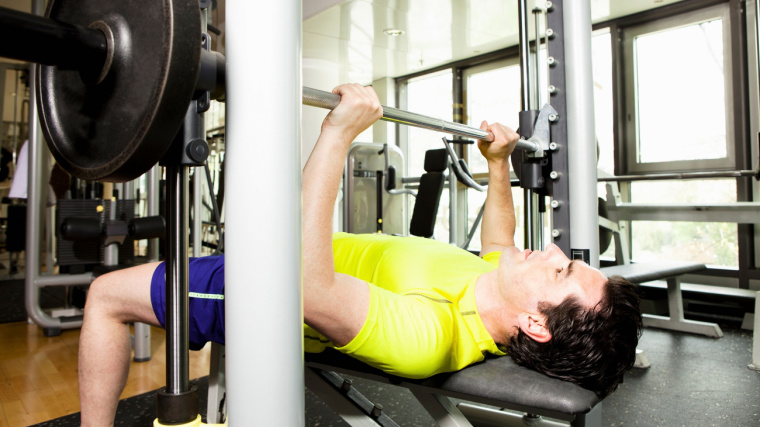 Credit: Image Source Trading Ltd / Shutterstock
Credit: Image Source Trading Ltd / Shutterstock
If you’re training alone, this is a tremendous asset. When you don’t know anyone who can spot you in the gym, the Smith machine comes with built-in safeties. A quick twist of your wrist, if you start failing a rep, can save you from a disaster. This way, you can load up feeling confident that you can safely miss your lift.
Muscle Gain
Similar to building strength, the Smith machine bench press makes it easy to chase major muscle gain. Squeezing out those last few repetitions — the ones that are the hardest and really challenge your progress — is a bit more intimidating on a free bench.
You’re going to need to push yourself, preferably with an experienced spotter, to accomplish progressive overload. The Smith machine helps reinforce your technique, safety, and confidence in training hard enough for muscle gain.
Muscles Worked by the Smith Machine Bench Press
Like any horizontal upper body pressing exercise, the Smith machine bench press primarily targets your chest, triceps, and shoulders.
Chest
The chest is the clear motivator behind nearly every horizontal pressing exercise. Your chest (or pectoralis major) is a fan-shaped muscle that attaches between your collar bone, sternum, and upper ribs to a..
body {
font-family: Arial, sans-serif;
margin: 20px;
}
h1 {
font-size: 28px;
font-weight: bold;
margin-bottom: 20px;
}
h2 {
font-size: 24px;
font-weight: bold;
margin-bottom: 15px;
}
p {
font-size: 16px;
line-height: 1.5;
margin-bottom: 15px;
}
Unleash Your Chest Gains: Mastering the Smith Machine Bench Press
The Smith Machine Bench Press: A Powerful Tool for Chest Development
The Smith Machine Bench Press is a popular exercise that can help you build a strong and well-defined chest. Whether you are a beginner or an experienced lifter, incorporating this exercise into your routine can take your chest gains to the next level.
Understanding the Smith Machine Bench Press
The Smith Machine Bench Press is similar to a traditional barbell bench press, but with the added advantage of a guided barbell. The machine consists of a fixed vertical barbell attached to a sliding track, allowing for controlled movement during the exercise.
Benefits of the Smith Machine Bench Press
1. Stability: The guided barbell provides stability and reduces the risk of injury, making it an excellent choice for beginners or those recovering from an injury.
2. Isolation: The Smith Machine Bench Press helps isolate the chest muscles, allowing for targeted muscle growth and development.
3. Versatility: The machine allows for various grip widths and positions, enabling you to target different areas of the chest, such as the upper, middle, and lower regions.
Proper Technique and Form
1. Set up the machine: Adjust the height of the barbell to a comfortable position. Ensure that the barbell is level and secure.
2. Position yourself: Lie flat on the bench with your feet firmly planted on the ground. Your eyes should be directly below the barbell.
3. Grip the bar: Place your hands slightly wider than shoulder-width apart on the barbell. Make sure your grip is firm and stable.
4. Unrack the bar: Engage your chest muscles and push the barbell up to unhook it from the safety latches. Hold the barbell directly above your chest with your arms fully extended.
5. Lower the bar: Slowly lower the barbell towards your chest while maintaining control and stability. Aim to bring it just below your nipple line.
6. Push the bar: Drive through your chest muscles and extend your arms to push the barbell back up to the starting position. Keep your movements smooth and controlled.
7. Repeat: Perform the desired number of repetitions, focusing on maintaining proper form throughout the exercise.
Tips for Maximizing Your Chest Gains
1. Warm-up: Prioritize a thorough warm-up routine to prepare your muscles for the workout and reduce the risk of injury.
2. Progressive overload: Gradually increase the weight you lift over time to continually challenge your muscles and promote growth.
3. Vary your grip: Experiment with different grip widths and positions to target specific areas of your chest and engage different muscle fibers.
4. Incorporate other exercises: Combine the Smith Machine Bench Press with other chest exercises, such as dumbbell flyes or cable crossovers, to add variety and stimulate muscle growth from different angles.
5. Focus on mind-muscle connection: Concentrate on engaging your chest muscles throughout the exercise, rather than relying solely on your arms or shoulders.
Conclusion
The Smith Machine Bench Press is a valuable tool for developing a strong and well-defined chest. By mastering proper technique, incorporating progressive overload, and implementing various strategies, you can unleash your chest gains and achieve the results you desire. Remember to consult with a fitness professional or trainer if you are unsure about performing this exercise correctly.







